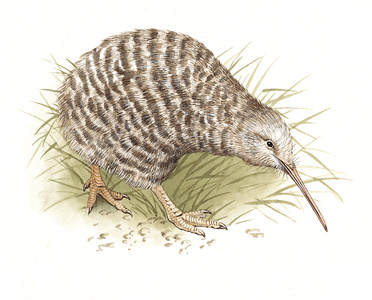Kiwi << KEE wee >> is a chicken-sized bird of New Zealand that cannot fly. Many kiwi live in New Zealand’s forests. People seldom see them, however, because the birds are shy and will usually run away when anyone comes near. There are five species (kinds) of kiwi.

A kiwi has a stocky body covered with shaggy, dull brown feathers. The feathers hang loosely and help keep the bird warm. The neck and legs of the kiwi are short, and its bill is long and flexible. A kiwi has no tail. Its tiny wings consist of only several stiff feathers. Kiwi are the only birds that have nostrils at the tips of their bills. They use them to smell food in the thick, wet forests where they live.
At night, kiwi feed on earthworms, insects, and berries. During the day, kiwi hide.
Kiwi often mate for life. The pair dig a nesting burrow around June and line it with leaves, moss, and other soft materials. A female kiwi lays one or two large white eggs during the months from August to January. Kiwi females lay the largest egg relative to body size of any bird. A kiwi egg may make up almost one-fourth of a female’s body mass. The male sits on the eggs for 60 to 90 days, until they hatch. Kiwi may live from 25 to 50 years.
Kiwi populations are severely threatened by human activity, habitat destruction, and introduced predators, including dogs, cats, and stoats. Conservation efforts include establishing protected habitats. Wildlife workers also collect kiwi eggs to incubate them in protected hatcheries. The young birds are then reintroduced into the forest.
People use the term kiwi as a nickname for a New Zealander. The term is also used for a member of an air service who is confined to ground duty.
